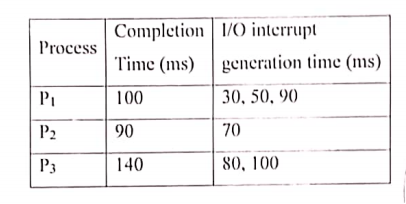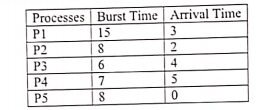Operating system all previous/ past question papers
– Operating system –Computer Science all subject past paper Operating system –Computer Graphics Course Operating system Project idea – ICT MCQ -Operating system Interview Question –Computer Science all courses -Technology –University Past Paper -Programming language –Question paper –old paper
Operating system Sessional I in 2020
Q#1: Differentiate and explain the followings,
(a) Multicore system and single core system
(b) Harmony OS vs Google Android
(c) Process and Control Block (PCB)
(d) Direct Memory Access and Indirect Memory Access
Q #2: How process changes its states? Explain in detail and draw state transition diagram. (4)
Q#4: How the Degree of multiprogramming is controlled in Time Sharing system?
Q# 5: Suppose there are three processes, P₁, P2 and Ps. CPU time slice 80ms, Short Term Scheduler (STS) 10ms, compute the CPU time in percentage used in processing User Jobs/process.

Operating system Sessional II in 2020
Q#1: (a) Apply Shortest Job First (SJF) in Pre-emptive and Non-Pre-emptive Modes and compute waiting time for each of the process and average waiting time of the system.(5+5)

(b) Write pseudo-code of SJF in Non-Preemptive mode.(5)
Q #2: Apply Round Robin CPU algorithm on following processes with Quantum-3ms and Quantum-7ms while Context Switch time is 5 micro seconds.(5+5)

Compute the CPU utilization time for user’s processes and system processes in both cases and identify which Quanta time is better in the above situation
Operating system Final paper in 2020
Q#1: Apply Shortest Job First (SJF) in Pre-emptive and Non Pre-emptive Modes and compute waiting time for each of the process and average waiting time of the system. (5+5)

Q#2: Write down short notes on the following terms. a. Hard and Soft affinity (Processor Affinity)
b. CPU Throughput c. Safe and Unsafe state of the system
d. Mutual Exclusion
e. Deadlock avoidance vs Deadlock Prevention
Q#3: Apply anker’s Algorithm to answer the following.

(a) Write the algorithm used to find safe scuence and also find safe sequence of the above processes, if any oly
(b) If a request from P’1 arrives for (1, 1, 0, 0), can it be granted immediately? A
(c) If a request from P4 arrives for (0, 0, 2, 0), can it be granted immediately?
Operating system Fall 20 in past paper
Q1: Choose the following.
- The minimum number of frames to be allocated to a process is decided by the……..
A) The amount of available physical memory B) Operating System
C) instruction set architecture D) none of the mentioned
| 2. The layer between the hardware and the user program isA.Operating environment B. System environment C. Operating system d. None D. All of the above2. Allocation of memory to each process according to its size is known as : A. proportional allocation algorithm B. split allocation algorithm C. equal allocation algorithm D. none of the above E. All of the above4. The resource management can be done in an operating system via A. space division multiplexing B. both time and space division multiplexing C. time division multiplexing D. none5. A high priority process is treated ___________ a low priority process, With either equal or proportional algorithm. A. lesser than B. greater than C. same as D. none E. All of the above6. The interface to access the services of the operating system is provided by_______ A. Assembly instructions B. API C. Library D. System calls E. Both A & C |
| 7. Which one is not a real-time operating system from the following? A. Palm OS B. Windows CE C. VxWorks D. RTLinux E. Both A & C F. None of these8. Medium-term scheduler is ______ ? A. It selects which process has to be executed next and allocates CPU B. It selects which process has to be brought into the ready queue C. Both B & D D. It selects which process to remove from memory by swapping E. None of the mentioned 9. In the PCB the context of a process does not contain : A. memory-management information B. the value of the CPU registers C. the process state D. Both B & D E. context switch time10. Does not interrupt a running process from the following? A. Timer B. A device C. Both A & E D. Scheduler process E. Power failure11. In the system _______ process can be affected by other processes executing? A. child process B. cooperating process C. Both A & B D. parent process E. init process12. If deadlocks occur frequently, the detection algorithm must be invoked ________ a) rarely b) frequently c) rarely & frequently d) none of the mentioned13. A system has 3 processes sharing 4 resources. If each process needs a maximum of 2 units then, deadlock ____________ a) can never occur b) may occur c) has to occur d) none of the mentioned15. Given a priori information about the ________ number of resources of each type that maybe requested for each process, it is possible to construct an algorithm that ensures that the system will never enter a deadlock state. a) minimum b) average c) maximum d) approximate14. A state is safe, if ____________ a) the system does not crash due to deadlock occurrence b) the system can allocate resources to each process in some order and still avoid a deadlock c) the state keeps the system protected and safe d) all of the mentioned 16. All unsafe states are ____________ |
Q2: Write a C/C++ program to calculate the average wait time for following process w.r.t their arrival time by using SJF algorithm. (8)
| Processes | Arrival time | Burst time |
| P0 | 0 | 7 |
| P1 | 1 | 5 |
| P2 | 2 | 3 |
| P3 | 3 | 9 |
Q3: Calculate the average wait time for following processes with the help of Gantt chart. (8)
Note: Calculate the time through Round Robib “RR” (Preemptive algorithm)
| Processes | Arrival Time | Burst Time |
| P1 | 0 | 8 |
| P2 | 1 | 4 |
| P3 | 2 | 9 |
| P4 | 3 | 5 |
Q4: Draw Diagram to present the working of (Different Scheduler, Scheduling, and Queues used in the system during process management and execution) along with the proper naming tags. (8)
Good Luck
Question 1
Marks (3) How user program is prevented from interfering with proper operation of the operating system? Briefly describe the mechanism used in Modern Operating system? CLO-14
Question 2
Describe the use of data structures linked list and bit-maps with proper examples?CLO-1
Marks (4)
Question 3
CLO-2 Marks (8)
When a child process is created, how can be address space, resources can be shared and execution can be done? Also give the reasons for your response?
Question 4
CLO-2 Marks (10)
Suppose there are four processes P₁, P₂, P, and P. in the main memory requiring CPU burst time 91, 87, 30, 120 mili seconds (ms) respectively. The arrival time of these processes are 1ms, 2ms, 10ms and 25ms. The processes P, and P are I/O bound and leave CPU after a burst of Ems and 10ms respectively and PI use I/O for 5ms and P2 for 7ms. Apply Shortest Remaining Job First. Draw Gantt chart and Compute waiting time for each of the process?
#Operating system#Computer Science all subject past paper Operating system #Computer Graphics Course #Operating system Project idea #Object oriented software engineering MCQ #Operating system Interview Question #Computer Science all courses #Technology #University Past Paper #Programming language #Question paper #old paper

